|
|
|
Sort Order |
|
|
|
Items / Page
|
|
|
|
|
|
|
| Srl | Item |
| 1 |
ID:
130667
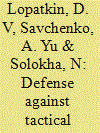

|
|
|
|
|
| Publication |
2014.
|
| Summary/Abstract |
The article focuses on tactical unmanned aerial vehicles (UAVs) and the need to develop an effective defense against drone attacks. Existing weapons and ways to defend against drones are presented. Problems discussed include challenges in detecting and destroying small size UAV's or drones. Options for defending against tactical drones including the use of laser as weapon, powerful electromagnetic impulses that disable drone equipment and drone hunter-killers are also presented.
|
|
|
|
|
|
|
|
|
|
|
|
|
|
|
|
| 2 |
ID:
130342


|
|
|
|
|
| Publication |
2014.
|
| Summary/Abstract |
As the U.S. government winds up an interagency review of rules governing the export of large drones, the conflicting goals of nonproliferation and commerce are creating a new test of the 27-year-old Missile Technology Control Regime (MTCR). Observers do not expect big changes to the MTCR, which seeks to prevent the proliferation of unmanned systems capable of delivering weapons of mass destruction. The MTCR, a voluntary arrangement that now includes 34 countries, originally was intended to curb the spread of ballistic missiles and unmanned vehicles capable of carrying nuclear weapons. In 1993 it was amended to control systems carrying any weapons of mass destruction. It has become Washington's chief tool for controlling the spread of armed drones. "It's quite unlikely that we will see any radical change in the MTCR," Eric McClafferty, an attorney at Kelley Drye and Warren, a law firm in Washington that represents UAV manufacturers, said in a March 19 interview. "That said, there's a lot of pressure on the U.S. government to liberalize controls to make sure the U.S. doesn't get left behind in this market." The conflict has played out in a series of closed-door meetings over the last two months among the State, Defense, and Commerce departments as officials seek to update U.S. policy toward the burgeoning UAV market. Industry representatives have made their views known via technical committees that advise policymakers in these departments. "It's a pretty contentious fight" between the State Department's Bureau of International Security and Nonproliferation and the Pentagon's Defense Technology Security Administration, said Micah Zenko, a fellow at the Council on Foreign Relations, in a March 17 interview. The State Department says that "if you pull at the thread of MTCR, you will weaken the nonproliferation regime as a whole. The other side says the international market is going to supply these UAVs anyway," Zenko said. The heart of the issue is what kind of UAVs U.S. manufacturers can sell overseas. The MTCR imposes a "presumption of denial" for the export of so-called Category 1 UAV's, which are drones that can travel more than 300 kilometers with a payload of more than 500 kilograms. Drones that do not have those capabilities are classified as Category 2 UAVs and are not subject to such restrictive criteria. Two drones currently classified as Category 1-the Reaper, formerly known as the Predator, and the Global Hawk-have played a central role in U.S. aerial attacks on suspected Islamic militants in Pakistan, Somalia, and Yemen. Washington has approved the sale of an armed drone to only one country, the United Kingdom, although unarmed versions of these drones have been sold to Italy and South Korea.
The stakes of the MTCR review process are large politically and economically, observers say.
|
|
|
|
|
|
|
|
|
|
|
|
|
|
|
|
| 3 |
ID:
130676
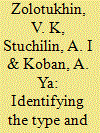

|
|
|
|
|
| Publication |
2014.
|
| Summary/Abstract |
The article discusses procedures for identifying the type and nationality of aerial vehicles to enhance effectiveness of airspace control during conflict situations. Capabilities of optoelectronic devices to gather information on class and type of aircraft are discussed. Images from a combination of optical detection instruments and radar obtained through experimental observations are presented to illustrate improvements possible to the image quality.
|
|
|
|
|
|
|
|
|
|
|
|
|
|
|
|
| 4 |
ID:
089101
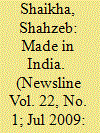

|
|
|
|
|
| Publication |
2009.
|
| Summary/Abstract |
It would come as a surprise to most Pakistanis that the country has an indigenous Unmanned Aerial Vehicle (UAV)industry. In fact , there are three private entities-East West Infiniti(EWI), Integrated Dynamics(ID) and surveillance and Target Unmanned Aircraft(Satuma)-involved in the manufacturing of UAVs in Pakistan.
|
|
|
|
|
|
|
|
|
|
|
|
|
|
|
|
| 5 |
ID:
132986
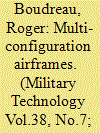

|
|
|
|
|
| Publication |
2014.
|
| Summary/Abstract |
Manned and un-manned airframe design combines aerodynamics, material technology and manufacturing methods to achieve balances of performance, reliability and cost, critical for today's shrinking defence budget.
|
|
|
|
|
|
|
|
|
|
|
|
|
|
|
|
| 6 |
ID:
133066
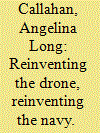

|
|
|
|
|
| Publication |
2014.
|
| Summary/Abstract |
Invention is often perceived as an isolated event, attributable to a momentous "first" or to a single, patent-holding inventor. However, rather than questioning what qualified as the first drone aircraft or to whom the title as its "inventor" belongs, this article maps out the winding uncertainties of technical evolution- exploring how seemingly failed projects laid groundwork for the U.S. Navy's first successful radio-controlled drone aircraft. Situated as they are among a cluster of interwar emerging technologies, drones provide an instructive case study through which to consider how the U.S. Navy's research-and-development (R&D) communities function as a strategic asset. When the availability of one subcomponent can jeopardize an entire research project, such factors as institutional stability, the circulation of ideas, and willingness to reevaluate naval doctrine become critical to national security. So too does the ability of experts to recognize a (perhaps temporary) dead end when they face one. This article will flesh out, for this case, the actors and activities of innovation, emphasizing how the collaborative nature of this work can mitigate the uncertainties
and risks of R&D.
|
|
|
|
|
|
|
|
|
|
|
|
|
|
|
|
| 7 |
ID:
189638
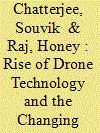

|
|
|
|
|
| Summary/Abstract |
The introduction of drones adds a new dimension to how the war is being fought nowadays. Military Unmanned Aerial Vehicles (UAVs) commonly referred to as drones have become the weapon of choice in modern warfare with state and non-state entities employing them to gain an upper hand over their immediate adversaries. The widespread of drones in modern warfare has gained a new dynamic and volatility as result of increased use and improved accessibility.Drones have evolved into an indispensable component of today’s military. This is because unmanned aircraft are a less expensive and safer alternative to human aircraft, and they may be used to gather intelligence and carry out targeted assaults. The recent conflicts between Armenia and Azerbaijan and the ongoing Russia-Ukraine war have seen extensive use of combat drones and drone swarms.
|
|
|
|
|
|
|
|
|
|
|
|
|
|
|
|
|
|
|
|
|